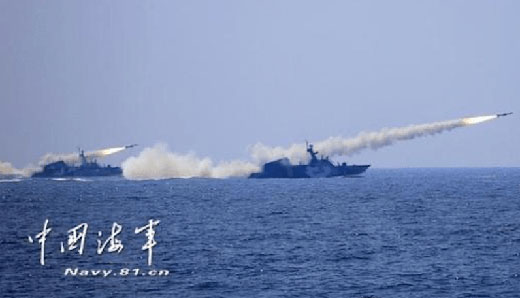by WorldTribune Staff, June 18, 2020
In April and May, as the world was dealing with the coronavirus pandemic which China was responsible for spreading worldwide, the People’s Liberation Army (PLA) was practicing blockade operations around Taiwan, with aircraft carriers and destroyers of the PLA Navy cooperating with anti-ship-missile-carrying H-6K bombers, about 100 of which are now with the PLA Air Force.
The PLA cordoned off a vast expanse of the Bohai Sea for more than 70 days in order to mobilize equipment and personnel for a series of live-fire drills to train for an amphibious landing on the mainland-facing shore of Taiwan.

“The most important objective for a PLA blockade of Taiwan will be to defeat U.S. forces already in Japan, Guam, and Hawaii that may try to assist Taiwan,” Richard Fisher noted in a June 16 analysis for The Epoch Times.
“After spending the past three decades preparing to conquer Taiwan, the Chinese regime has heightened its threatening military posture against the island democracy, with threats of blockade and invasion, in the first half of 2020. However, there are some who suggest that excessive U.S. support for Taipei could also cause a military crisis,” wrote Fisher, a senior policy analyst with the International Assessment and Strategy Center and Geostrategy-Direct.com contributing editor.
In a June 3 article in The Diplomat, Daniel Russel, the Obama administration’s former assistant secretary of state for East Asia, asks whether there may be a “perfect storm” that could cause China to attack independent Taiwan, with “unification” being a political and strategic imperative for Chinese Communist Party (CCP) leader Xi Jinping.
Russel observes that CCP anxieties are heightened as its political warfare strategy touted as a “solution” of “one country, two systems” was rejected in Hong Kong.
This rejection “was linked to supporting opposition by Taiwan President Tsai Ing-wen, who has been strengthened by her re-election in January and her leadership in preventing massive deaths from the CCP virus, commonly known as the novel coronavirus,” Fisher noted.
Russel went on to say that, in some ways, support for Taiwan given by the Trump administration and the U.S. Congress may not be “comparable to steps taken by previous administrations,” suggesting, the “painstakingly constructed framework of the ‘one China policy’ may not survive if Taiwan is used as an instrument of pushback against China.”
Following the de-recognition of Taiwan in 1979, the “our one China policy” largely created by the State Department guided U.S. relations with “non-state” Taiwan. A major goal of that policy was to limit arms sales to Taiwan so that it wouldn’t obtain “offensive” military capabilities that might anger China.
“Aspects of this were continued by the Obama administration, which didn’t sell Taiwan a single decisive new weapon system,” Fisher noted. “It was the Trump administration that sold upgraded F-16 fighters to Taiwan in 2019, despite requests going back to the George W. Bush administration.”
How China responded to U.S. Arms Sales Restraint
“Following the 1989 Tiananmen Square Massacre in Beijing, the CCP embarked on a massive program of technical investment to propel a military buildup designed to make China the world’s preeminent military power, with the early goal of a military conquest of Taiwan if it couldn’t be coerced into surrender,” Fisher wrote.
Today, the PLA Navy has two aircraft carriers, 20 modern air defense destroyers, 40 new anti-submarine warfare frigates, and 65 modern conventional submarines for naval blockade operations.
In July 2019, the PLA Rocket Force tested its 1,700-km (about 1,056 miles) range DF-21D anti-ship ballistic missiles (ASBMs) as part of exercises in the South China Sea.
“These are difficult to shoot down and will be coordinated with air-launched ASBMs fired by H-6N bombers, anti-ship cruise missiles fired by H-6K bombers, and cruise missiles fired by PLAN submarines,” Fisher noted. “The one U.S. Navy aircraft carrier battle group based in Japan may not survive such an onslaught of PLA missiles. PLA Rocket Force 4,000-km (almost 2,500 miles) range nuclear- and ASBM-capable DF-26 missiles can reach Guam.”
The defeat of U.S. forces and a blockade of Taiwan will likely precede its invasion, “which the PLA has been building toward for 30 years,” Fisher wrote. “Following reforms of late 2015, the amphibious PLA Marines are being expanded as is the PLA Airborne Force, intended to capture ports and airfields for follow-on forces. Scores of large civilian roll-on-roll-off (RORO) ferries and large car carriers stressed for heavy armor will carry the bulk of PLA troops and armor to Taiwan. Chinese airlines alone could move hundreds of thousands of troops to captured Taiwan airfields.”
Fisher continued: “Arming Taiwan and modernizing U.S. forces in Asia offers the greatest chance for preventing a Chinese attack that could also engulf the United States in war. A CCP-controlled Taiwan will quickly become a PLA naval and nuclear military base that will isolate U.S. ally Japan and better enable the global projection of the PLA. Democratic Taiwanese will then face mass executions, imprisonment, and CCP totalitarian oppression.
“Washington now has precious little time to rebuild U.S. military strength in Asia and to change U.S. policy by helping Taiwan to rapidly acquire ‘offensive’ military capabilities to attack advancing PLA invasion forces. To its credit, the Trump administration is now developing new short-, medium- and intermediate-range missiles and very-long-range artillery to begin to address the PLA’s nearly 2,000 theater-range missiles. It’s time to sell Taiwan 500- to 1,000-km range missiles to attack PLA embarkation points.
“It’s also necessary to consider an emergency shipment of 200 of the 300-km range ATACMS (Army Tactical Missile System) short-range ballistic missiles.
“Washington and Taipei can take measures now to deter a Chinese invasion. Tsai recently committed to increasing the size of Taiwan’s reserve forces, and Taiwan is beginning to produce some ‘offensive’ missiles. Washington can end the failed ‘restraint’ of ‘our one China policy’ and enable Taiwan to destroy PLA invasion forces before they can cross the Taiwan Strait.”
Intelligence Brief __________ Replace The Media
